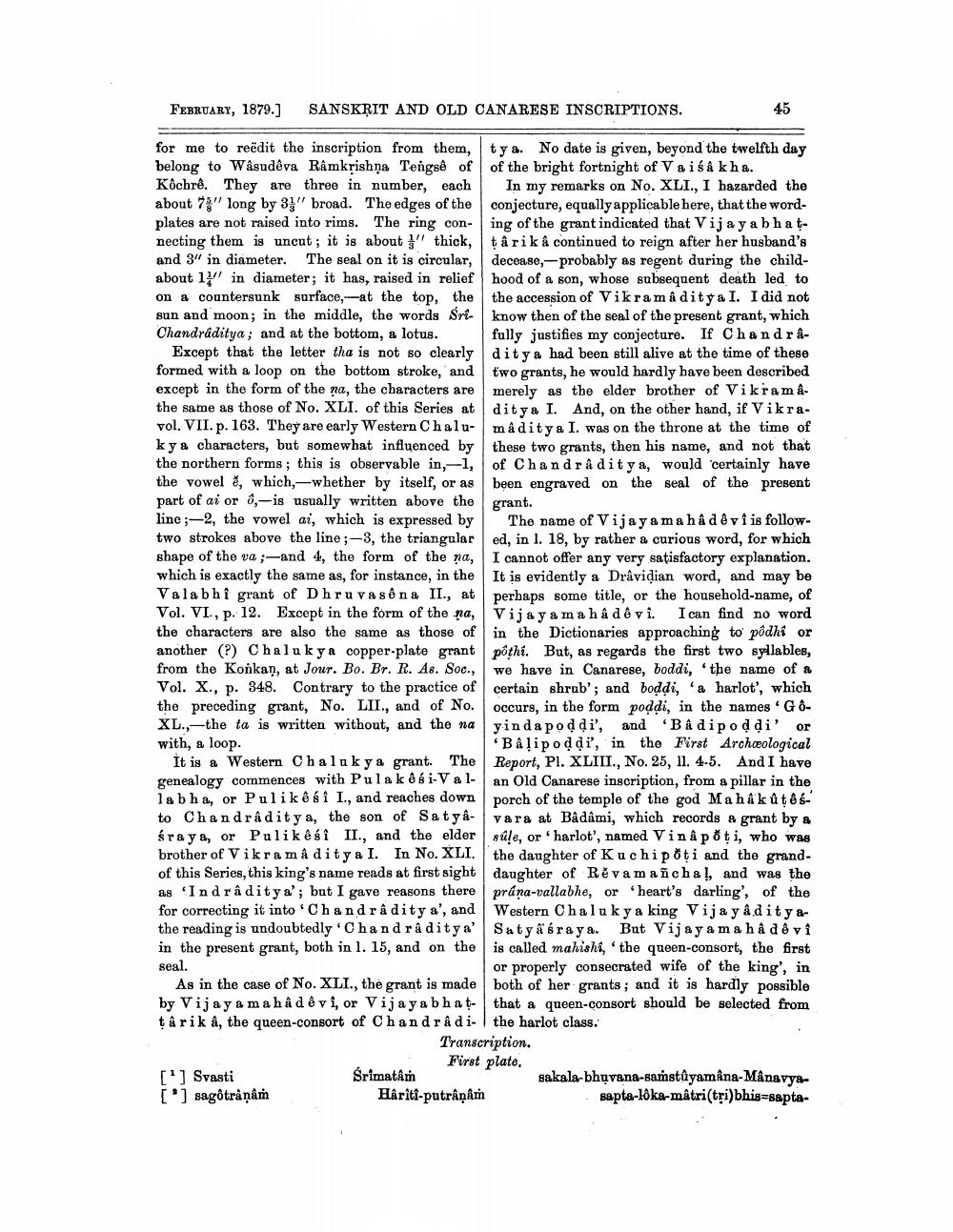________________
FEBRUARY, 1879.)
SANSKRIT AND OLD CANARESE INSCRIPTIONS.
45
for me to reëdit the inscription from them, tya. No date is given, beyond the twelfth day belong to Wasudeva Ramkrishna Tengsê of of the bright fortnight of Vaisakha. Kôchre. They are three in number, each In my remarks on No. XLI., I hazarded the about 7" long by 31" broad. The edges of the conjecture, equally applicable here, that the wordplates are not raised into rims. The ring con- ing of the grant indicated that Vijay a bhatnecting them is uncut; it is about thick, tarik & continued to reign after her husband's and 3" in diameter. The seal on it is circular, decease, probably as regent during the childabout 1% in diameter; it has, raised in relief hood of a son, whose subsequent death led to on a countersunk surface,-at the top, the the accession of Vikramaditya I. I did not sun and moon; in the middle, the words Sri- know then of the seal of the present grant, which Chandráditya; and at the bottom, a lotus. fully justifies my conjecture. If Chandra
Except that the letter tha is not so clearly dit ya had been still alive at the time of these formed with a loop on the bottom stroke, and two grants, he would hardly have been described except in the form of the na, the characters are merely as the elder brother of Vikram - the same as those of No. XLI. of this series at ditya I. And, on the other hand, if Vikravol. VII. p. 163. They are early Western Chalu-maditya I. was on the throne at the time of kya characters, but somewhat influenced by these two grants, then his name, and not that the northern forms; this is observable in,-1, of Chandråditya, would certainly have the vowel X, which, -whether by itself, or as been engraved on the seal of the present part of ai or 0,- is usually written above the grant. linc;—2, the vowel ai, which is expressed by The name of Vijayama hade vi is followtwo strokes above the line ;-3, the triangular ed, in 1. 18, by rather a curious word, for which shape of the va ;-and 4, the form of the na, I cannot offer any very satisfactory explanation. which is exactly the same as, for instance, in the It is evidently a Dravidian word, and may be Valabh i grant of Dhruvasê na II., at perhaps some title, or the household-name, of Vol. VI., p. 12. Except in the form of the na, Vijay a ma ha dê vi. I can find no word the characters are also the same as those of in the Dictionaries approaching to pôdhi or another (?) Chaluky a copper-plate grant pothi. But, as regards the first two syllables, from the Konkan, at Jour. Bo. Br. R. As. Soc., we have in Canarese, boddi, the name of a Vol. X., p. 348. Contrary to the practice of certain shrub'; and boddi, 'a harlot', which the preceding grant, No. LII., and of No. occurs, in the form poddi, in the names GôXL.,-the ta is written without, and the nayinda pod di', and 'Badipod di' or with, a loop.
Bå lipodai', in the First Archæological It is a Western Chaluky a grant. The Report, Pl. XLIII., No. 25, 11. 4-5. And I have genealogy commences with Pulak & si-Val- an Old Canarese inscription, from a pillar in the la b h a, or Pulike si I., and reaches down porch of the temple of the god Ma hâk û tê sto Chandråditya, the son of Satya-vara at Badâmi, which records a grant by & śraya, or Pulik esi II., and the elder súle, or "harlot', named Vin & poti, who was brother of Vikramaditya I. In No. XLI. the daughter of Kuchipoti and the grandof this series, this king's name reads at first sight daughter of Rě vamañcha!, and was the as 'Indraditya'; but I gave reasons there prána-vallabhe, or heart's darling', of the for correcting it into Chandrådity a', and Western Chaluky a king Vija y adityathe reading is undoubtedly Chandra ditya' | Satyasraya. But Vijay a ma ha de vi in the present grant, both in l. 15, and on the is called mahishi, the queen-consort, the first seal.
or properly consecrated wife of the king', in As in the case of No. XLI., the grant is made both of her grants; and it is hardly possible by Vijay a ma ha d è vi, or Vijayabhat-that a queen-consort should be selected from tarik , the queen-consort of Chandra di-the harlot class.
Transcription.
First plate. ['] Svasti Srimatâm
sakala-bhavana-samstůyamåna-Månavya['] sagôtråņam Hâritî-putrânâm
sapta-loka-matri(tri)bhis=sapta




